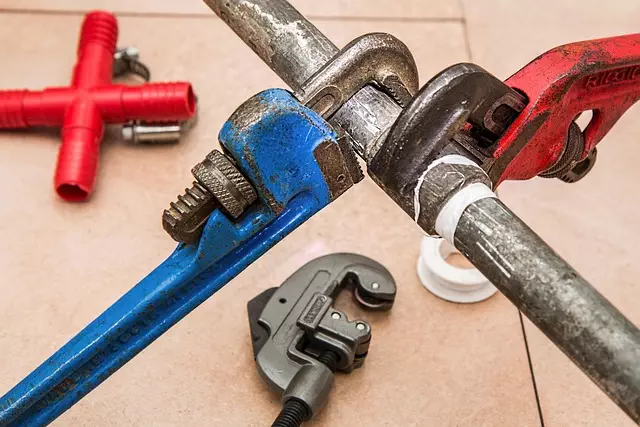This text provides a comprehensive guide to fixing concrete wall cracks (stem wall repair), emphasizing the importance of thorough inspection and crack severity assessment. Different crack types require distinct repair methods, from DIY epoxy for minor cosmetic issues to complex stem wall repair techniques for structural problems. Effective repairs involve cleaning, mixing compounds carefully, and proper application with tools. Preventive measures like regular maintenance and early intervention are crucial for prolonging wall longevity. Common mistakes to avoid include failing to identify root causes and using unsuitable materials or methods. Always research compatible stem wall repair products based on moisture resistance, strength, and compatibility with your wall material.
“Discover effective solutions for tackling wall crack repairs with our comprehensive guide. Wall cracks, whether structural or cosmetic, demand meticulous attention. We’ll delve into the intricacies of understanding various crack types and their causes, offering a step-by-step approach to repairing concrete walls, especially stem walls. Learn about essential tools and materials while exploring preventive measures to ensure long-lasting wall integrity. Avoid common mistakes and master the art of stem wall repair for a robust, seamless finish.”
Understanding Wall Cracks: Causes and Types

Wall cracks can be both aesthetically displeasing and a cause for concern, especially when they signal deeper structural issues. Understanding the causes and types of wall cracks is essential for effective stem wall repair. These cracks often result from various factors such as settlement, environmental conditions, poor initial construction, or excessive movement due to earthquakes or soil shifts.
There are several types of wall cracks, each with its unique characteristics. Hairline cracks, typically thin and shallow, might be caused by minor movements or thermal expansion. Larger, wider cracks could indicate more significant structural problems, like foundation settling or water damage. Identifying the specific type of crack is crucial as it determines the appropriate repair method, whether it’s simple cosmetic fixes for smaller cracks or complex stem wall repair techniques for more severe cases.
Inspection: Assessing the Damage and Choosing the Right Repair Method

When it comes to wall crack repair, the first step is a thorough inspection. This involves assessing the extent of the damage and identifying the type of crack – whether structural or cosmetic – as well as its location and size. For instance, a stem wall repair requires a different approach than a minor hairline fracture. During this phase, you also need to consider the cause of the crack, such as settling, water damage, or foundation shifts.
Choosing the right repair method depends on these factors. For structural cracks, professional intervention is crucial to ensure stability and safety. This might involve underpinning or replacing damaged sections. For cosmetic cracks, however, DIY solutions like filling and sealing with appropriate epoxy or mortar could be sufficient. An accurate inspection guides you towards selecting the most effective, long-lasting, and cost-efficient repair method.
Materials and Tools for Stem Wall Repair

When it comes to repairing stem wall cracks, having the right materials and tools is essential for a successful and long-lasting fix. The first step is to gather the necessary equipment, including a wire brush or power washer to clean the crack and remove any loose debris. This ensures a solid surface for application and prevents future issues.
For the actual repair, you’ll need a suitable epoxy or sealant designed specifically for stem wall cracks. These products are typically two-part compounds that, when mixed correctly, create a strong bond. A putty knife is an indispensable tool for applying the material, allowing for precise filling of the crack and creating a smooth finish. Additionally, a plastic spatula can be useful for blending and smoothing the repair compound.
Step-by-Step Guide to Fixing Cracks in Concrete Walls

Fixing cracks in concrete walls, often a sign of structural issues or environmental stress, is crucial for maintaining your space. Here’s a step-by-step guide to tackle stem wall repair effectively. Begin by assessing the crack’s severity. For minor cracks, use a chisel and hammer to remove loose debris from the crack, creating a clean surface. Next, mix a suitable epoxy or hydraulic cement based on the manufacturer’s instructions. Ensure it matches the concrete’s composition for a strong bond.
Apply a thin layer of the mixed compound into the crack using a putty knife, filling it completely. Smooth the surface with the knife to ensure even coverage and let it cure as per the product guidelines. After curing, inspect for any gaps or weak spots, and if necessary, repeat the process for a more robust repair. This method effectively addresses both cosmetic and structural stem wall repair needs.
Preventive Measures: Strengthening Your Walls for Longevity

To ensure long-lasting walls, preventive measures are crucial. Regular maintenance and early intervention can significantly extend the life of your walls and prevent costly repairs down the line. One effective strategy is to address any signs of damage promptly, such as cracks or bulges. A stem wall repair, for instance, should not be delayed if a crack appears, as it could indicate underlying structural issues.
Regular inspections are key to identifying potential problems early. Check walls for any signs of movement, cracks, or water damage, especially in areas prone to extreme temperatures or high humidity. Strengthening your walls through proper bracing and support can prevent minor flaws from escalating into major repairs. Additionally, using high-quality materials during construction or renovation projects can contribute to the overall durability and resilience of your walls against time, elements, and structural stress.
Common Mistakes to Avoid During the Repair Process

When tackling wall crack repair, especially stem wall repair, it’s crucial to be aware of common mistakes that can compromise the integrity of your structure and lead to future issues. One of the most frequent errors is attempting to fix a crack without properly assessing its cause. Wall cracks often signal underlying problems like settlement, moisture intrusion, or structural damage, which require specialized attention. Ignoring these root causes can result in temporary fixes that fail over time.
Another mistake is using unsuitable materials or methods for the specific type of crack and wall construction. Different walls—whether they’re concrete, brick, or drywall—have unique needs. Using the wrong adhesive, filler, or sealer can lead to poor bonding, further weakening the repair and making it more susceptible to future damage. Always research and select products suitable for stem wall repair, considering factors like moisture resistance, strength, and compatibility with your wall’s material.
